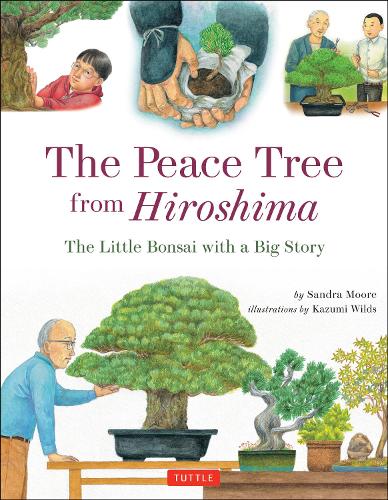
The Peace Tree from Hiroshima: The Little Bonsai with a Big Story
(Hardback)
Publishing Details
The Peace Tree from Hiroshima: The Little Bonsai with a Big Story
By (Author) Sandra Moore
Illustrated by Kazumi Wilds
Tuttle Publishing
Tuttle Publishing
14th July 2015
United States
Classifications
Children
Fiction
813.6
Physical Properties
Hardback
32
Width 216mm, Height 279mm
482g
Description
Age: 8 to 12
"This is a story about the art of caring. Its message will speak to the heart of any child who reads it and nourish his or her roots in the process" - Ron Himler, illustrator of Sadako and the Thousand Paper Cranes
Centuries ago, a Japanese white pine tree grew on the island of Miyajima in Japan. While the tree was still young, it was gently uprooted and taken to join the Yamaki family at their home in Hiroshima, where it was lovingly pruned and trimmed into a beautiful bonsai tree. Told from the perspective of the little tree, this astonishing true story is a tale of survival, hope, and friendship. Time passed happily for the little tree, until the morning of August 6, 1945, when an atomic bomb destroyed Hiroshima. Many people died, but the Yamaki family and Miyajima, along with all their other bonsai trees, survived the tragedy. Life went on for the little tree, until one day in 1976, a truck arrived to take Miyajima away. The little bonsai tree was on its way to the National Arboretum in Washington, DC, as a gift of friendship from Japan to America. Miyajima was so proud to be a part of this gift, but also very sad to leave the Yamaki family and his home. Many years later, Masaru, the elderly grandfather of the Yamaki family, and his ten-year-old grandson, Akira, make a surprise visit to Washington. They head directly to the National Arboretum to visit their much missed and beloved family member, Miyajima.
"How can one explain to children the effects of a nuclear bomb, and how it impacts people around the world It can be an awkward subject. Countries that were at one time enemies but are now allies can set a good example for the world. It all starts with one little saplingTrees have great memories, and I do hope that humankind will remember the atrocities of the past (and present) and find ways to live more peacefully in the future. I am pleased that there isa children's book, inspired by a true event that sheds a positive light on a harsh subject." Castle View Academy blog
"The Peace Tree from Hiroshima by Sandra Moore is a beautiful story that weaves together history, geography, family, nature, sadness, peace, and hope. [It] will captivate your children from the first page[It] can lead to a variety of learning opportunities." MyLittlePoppies.com blog
"Wilds' full-page landscape illustrations are the best: lush green forest teaming with flora and fauna, the stark and monochrome shock of a bombed city, and the gorgeous blue sky and pink blossoms of a rebuilding land. Moore's use of a novel perspective gives way to a discussion about the meanings of history, war, and peace." Asian Fortune News
Reviews
"This is a story about the art of caring. Its message will speak to the heart of any child who reads it and nourish his or her roots in the process." --Ron Himler, illustrator of Sadako and the Thousand Paper Cranes
"this 350-year-old bonsai had survived the atom bomb dropped on Hiroshima! No one in America knew anything about this until then. The survival of this old bonsai, which had been sitting on a bench behind a wall at the Yamaki home not far from the epicenter of the blast, was in and of itself astonishing. But just as amazing were the facts that Mr. Yamaki had not mentioned this critical fact when he donated the bonsai, that he had given such a masterpiece to America, his former enemy, and that in making the gift Mr. Yamaki must have been forgiving America for dropping the bomb on his home city. In an instant, the Yamaki Pine became an international symbol of peace." --Felix Laughlin, President of the National Bonsai Foundation
"I would recommend this book to children who are eager to learn about history from other cultures and as a starter to get kids interested in nature. The story is personal and sentimental, but is able to cross the bridge from nature to other cultures." --Washington Gardener magazine
Author Bio
Sandra Moore began her writing career as a ghostwriter for a senator on Capitol Hill and has worked as a freelance journalist specializing in writing about children and families. She studied writing for children at the Washington Writers' Center. This is her first book.
Kazumi Wilds illustrated Tuttle's All About Japan (Tuttle, 2011) and has illustrated several other children's books, including The Wakame Gatherers (Shen's Books, 2007). She lives in Japan but is currently studying in the United States. See her work at wildskazumi-picturebook.jimdo.com
